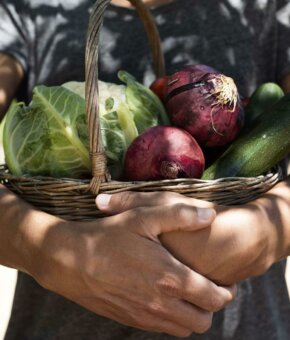
An increasing number of chefs are realizing how their kitchen can be a place of positive impact on people and the planet. By growing their own produce and cooking with locally sourced, fresh and organic ingredients, they are contributing to a changing food system. Meet 12 chefs that are keeping their dishes as local as possible.
1. Amass – Copenhagen
Leafy vegetables, berries, herbs, edible flowers: over 80 varieties of crops are grown at the garden of Amass, described by the team as the ‘soul of the restaurant’. It’s the place where food is sourced and where inspiration for new recipes is born. To create an even bigger impact, the Amass Green Kids Program plants, grows, harvests, and cooks a season’s worth of vegetables with inner-city school children. Kids and their families are invited for a meal made solely with produce they cultivated and cooked themselves. Amass is also a member of Foodprint Nordic, through which it donates one percent of its menu price to regenerative agriculture projects.
2. Rosemary’s – New York
Named after the mother of founder Carlos Suarez, Rosemary’s is committed to serving its neighbors with the same devotion that Rosemary herself extends to her family and guests. The herbs and vegetables served at this cozy Italian spot in New York are supplied by the farm located on top of the restaurant.
3. Avling – Toronto
Avling is a restaurant, rooftop farm and brewery in one. This buzzing space in downtown Toronto’s east side has sustainability at the core of its business. The owners are constantly trying to take it a step further, for example by experimenting with on-site wastewater treatment, so wastewater from the brewery can be reused to irrigate the organic vegetable garden.
4. Bakkal Farm – Marrakech
Free from pesticides and full of taste, color, and nature. Bakkal Farm is a true edible paradise with over 200 varieties of crops. The farm supplies its own restaurant, hotel lodge and a shop, where the urban dwellers of Marrakech can get their hands on fresh and organic produce.
5. Nature Urbaine – Paris
Paris has been famous for centuries for its refined cuisine. But just like the majority of large cities, it highly depends on external food supplies. Nature Urbaine, a 14,000 square meter rooftop farm, is contributing to a shift towards a local and sustainable food system. The rooftop farm produces up to a thousand kilos of fresh produce per day, part of it being used by the chefs cooking at the restaurant located on the same roof.
6. Three Blue Ducks – Byron
Three Blue Ducks is stirring up the future of food all throughout Australia, with locations in Byron, Melbourne, Rosebery, Brisbane and Nimbo. Their motto ‘Grow, Feed, Educate’ inspires all that they do. The founders believe that the first-hand experience of seeing how food is grown and produced makes the eating of it so much more pleasurable. Set on an 80-acre farm in Byron, complete with 700 chickens and a macadamia orchard, Three Blue Ducks is living proof of how different our food system can be and how restaurants can contribute to that.
7. The Margi – Athens
This lush 20,000 square meter garden created in 2015 just outside of Athens is a paradise for both nature lovers, foodies and chefs. The restaurant of the Margi hotel is sourcing its organic vegetables, fruit, cheese, eggs and olive oil straight from the farm.
8. Ceres Justos – Medellin
Ceres Justos combines a restaurant with a zero waste shop and urban farm, all in an effort to contribute to a greener and more sustainable world. At Ceres Justos, they believe that what’s on your plate can (and should) have a positive impact and that by changing our daily habits we can make that happen.
9. La Pebeta – Buenos Aires
Not a restaurant with a farm, but a farm with a restaurant. Located just outside of the Argentinean capital, La Pebeta is cooking at the same rhythm the vegetables grow. The menu is changing weekly and depends on what the vegetable garden has to offer at that moment. Harvest is also partly available for visitors to take home.
10. Cultiva Kenya – Nairobi
Ariel Moscardi – originally from Ecuador – started Cultiva Kenya as a pop-up concept in 2019. Three years later, the restaurant is employing 35 locals and is cultivating anything from broccoli to black kale and red cabbages. Cultiva Kenya heavily promotes crop variety. “Here, there are probably 50 varieties of tomatoes but we only have a few in the supermarket. Who is keeping alive all the ancestral varieties of Kenya?” argues Moscardi.
11. 1-Arden Food Forest – Singapore
Singapore is taking serious steps to become less reliant on importing food. Urban farms are popping up everywhere, including high up in the sky. 51 floors up in the middle of the Central Business District, the 1-Arden Food Forest is providing fresh produce to two restaurants and sparking creativity amongst the chefs. “If not for the 1-Arden Food Forest being just steps away from our restaurant, we wouldn’t have been exposed to the micro-seasons and micro-climates, and discovered the use of plants in the different stages of their life cycle,” said Lamley Chua, head of Japanese Culinary Development.
12. Boragó – Santiago de Chile
Listed in the top 50 best restaurants of the world, Boragó is taking local to the next level. The water served at the table is coming from Patagonia’s rain, the restaurant is growing vegetables at its own urban farm and there is no wine list. Instead, wine is sourced from local family projects. As Boragó is working with produce that’s highly seasonal, the menu is constantly changing.
Were you inspired by these restaurants growing their own food? Check out this zero waste restaurant or learn how this company helps restaurants to divert waste from landfill. Also make sure to sign up for our monthly newsletter, to never miss a story.
Header image: Chiarascura / Shutterstock.com



